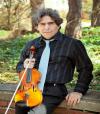Suggest Treatment For Occipital Headaches And Tremors

Another odd symptom I have - which may not be related - is that when I take a vigorous walk - when I stop , I have a vision distortion for about 3 minutes - like a pond rippling effect in my vision. This was happening before this right side issues - but I didn't want to leave this oddity out.
I have had a brain CT scan it is is clean/a-okay. Could this be a shoulder blade nerve impingement?? I was dumped/bucked off a horse in 2009 onto a hard patch of ground - on my right side - hitting on my shoulder. BUT my symptoms didn't really start happening until 2012 (onset of a period of horrible right occipital headaches for many months and overall feeling of weakness and tremor on right side).
Just FYI - in the course of my trying to find answers for these problems, we have discovered thyroid carcinoma and Hashimotos (got complete thyroidectomy as a result, in XXXXXXX 2013) and also a splenic aneurysm (1.2cm) - being monitored annually.
Possible Occipital Neuralgia vs. Post concussive CRPS
Detailed Answer:
Good evening.
Thank you for your questions and sufficiently detailed explanation of the incidents involving the fall from the horse as well as the evolution of these headaches and at times NON-headache symptoms.
It is very likely in my opinion that you are describing among other things a type of headache referred to as an OCCIPITAL NEURALGIA and this can originate traumatically and be an entrapment of the GREATER OCCIPITAL nerve within soft tissues overlying the upper neck and skull areas. There may also be another component at play which is a post concussive or perhaps better phrased, POST TRAUMATIC consequence of the blow to the head, neck, and body when you fell from the horse and that would be what we call COMPLEX REGIONAL PAIN SYNDROME (CRPS). The older term for this entity is REFLEX SYMPATHETIC DYSTROPHY. It is usually seen in cases where long bones are fractured or soft tissues such as ligaments, tendons, muscles, or nerves are severely stretched and/or torn violently from trauma and blunt force injury.
A fall from a horse certainly qualifies. The only part of the story that is slightly difficult to explain is the protracted time lag between 2009 and 2012 when you report the actual onset of major noticed symptoms. Nevertheless, just as the XXXXXXX Indians ALMOST won the World Series and The XXXXXXX Cubs DID WIN the World Series....strange things in medicine can also happen....so perhaps, there are reasonable scenarios where major damage can occur but not manifest itself as aberrant pain syndromes for several years.....The symptoms of electricity and the headaches can be a manifestation of CRPS.....The headaches and rippling water effects can be migrainous features of traumatic postconcussive headaches.
I realize that you said you didn't really strike your head when you fell from the horse and while it may be the case that the head did not contact the ground the sheer force from an uncontrolled fall that abruptly stops the head can result in whiplash effects causing the brain to still STRIKE with quite a bit of acceleration the inner tables of the skull back and forth resulting in a mild form of concussion which may not have been as noticeable at the time until later the headaches began.
My recommendation is that you secure 3 further opinions from someone who can more thoroughly examine you for these conditions:
1. Headache specialist/Neurologist
2. Pain Expert (but one who in addition to being able to adequately treat with appropriate interventions is also interested and knowledgeable in making the call of CRPS vs. some other ORTHOPEDIC abnormality which may also be at play)
3. Orthopedic or Physical Medicine Rehabilitation Specialist who will thoroughly examine your cervical spine for ligamentous problems or chronic subatlanto-occipital joint subluxations.
I believe at least a SPIRAL CT of the cervical spine should be obtained along with an MRI of the cervical spine with contrast in order to demonstrate chronically damaged or inflamed connective tissue scarring.
Now, one final caution. I do not advocate (and I believe most neurologists agree with this point) the use of CHIROPRACTIC manipulations of the neck in these cases...no matter whether or not someone claims to be able and prove entrapment or chronic subluxation problems. The idea of rapid head-thrusts to "realign" spinal columns and necks is one which is fraught with complications even though the literature is controversial on the topic. I've seen very bad consequences (even 1 case of fatal embolic stroke and vertebral artery dissection) occur in a young woman who was less than 90 minutes post neck manipulation from a chiropractor). 2 other cases with similar stories ended up with serious and permanent sequelae of strokes of the brainstem which left them partially paralyzed and fully dysfunctional.
I don't mind a patient trying acupuncture and even deep massage therapy though that should also be done with the clear understanding that the massotherapist should stay well clear of the great vessels of the neck and concentrate only on muscles, tendons, and ligaments...tough to do for anatomic reasons when in the neck.
If I've adequately answered your questions could you do me a huge favor by CLOSING THE QUERY and being sure to include some fine words of feedback along with a 5 STAR rating if you feel my suggestions have helped? Again, many thanks for posing your questions and please let me know how things turn out.
Do not forget to contact me in the future at: www.bit.ly/drdariushsaghafi for additional questions, comments, or concerns having to do with this topic or others.
This query has utilized a total of 27 minutes of professional time in research, review, and synthesis for the purpose of formulating a return statement.
Answered by

Get personalised answers from verified doctor in minutes across 80+ specialties



